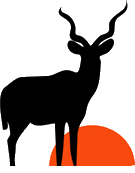
You will need to complete an arrival form at immigration where you will be required to state your address in Namibia. Please use the following address: Wildernis No. 957 Grootfontein, Namibia.
All International flights end and start in Windhoek, the Capital of Namibia. Wildernis Trophy Hunting is approximately 570 Kilometers North East of Windhoek which translates to a 6 hour drive. We recommend travelling during daytime. Namibia is known for wild animals crossing the road especially during night time, making driving at night time dangerous.
Charter flights can be arranged to pick you up at Hosea Kutako International Airport and transfer you to a landing strip nearby. Please contact us for any information regarding this service. We recommend that you carry all valuables, essentials such as medications and one change of clothing plus your hunting boots, in your carry-on luggage in case your checked bags are delayed or lost.
Wildernis Hunting has a number of various weapons available to you at an additional fee, allowing you to save the time needed for relevant weapon documentation needed by South African and Namibian Authorities. However should you choose to bring your own weapons please contact us to assist you with the relevant information and documentation.
Travel Info
HUnting Seasons
The Namibian Hunting Season is from February to end November. The rainy season is normally from December to April and the mild winter season from May to August, with temperatures between 40 to 70 degrees Fahrenheit.
The best hunting months are normally from late April to end of September. Depending on our rainy season, May is still green and the bush thick which makes hunting difficult but also very challenging.
May is one of the popular hunting months, but the best hunting months are June and July. We recommend August and September for bow hunting, due to the drier weather conditions animals tend to drink more water at the waterholes
As for hunting guides we have chosen to use members of the local community who are fully qualified at international standard.
They had the privilege of growing up in the bushveld and have more knowledge and experience than any book can promise.
Most hunting is done by the walking and stalking method to give hunters a traditional and memorable African experience.
Well equipped gun and bow hides are located at various water points to test every hunter’s patience to its limits.
Hunting
Trophy information
We make use of Casper Taxidermy in Grootfontein.
Casper can be contacted at:
[email protected] / [email protected]
or visit his website at:
www.capers-taxidermy.com
Light clothing made from breathable fabric such as cotton, in camouflage colours like greens, browns, khaki and olive, are most recommended for hunting.
Think layers – daily temperature changes in Namibia can be extreme, varying by as much as 20°C (35° F) from day to night. In the rainy season we recommend you bring some fast-drying synthetic clothing that maintains its warmth when wet. (We do laundry daily, so bear that in mind when packing).
Long sleeve shirts and pants assist with protection against the sun and thorns of the bush. A good hat to protect your neck and ears against the sun is a necessity in Namibia.
Warm clothing is a must in the winter months, between May and September. You’ll need a warm jacket for relaxing around the open fire, and the addition of gloves, a woolly hat and a wind breaker will come in handy when travelling on the back of the hunting vehicle in the early mornings and late afternoons.
Two pairs of well worn walking boots are recommended with thick socks. We recommend that you wear gaiters to protect your socks and also to keep out excess sand. We do have gaiters in stock that is made of good quality leather by a local supplier.
We also recommend the following:
- Odorless sunscreen with a minimum SPF of 20, insect repellant, and lotion/lip balm (for a dry climate) will come in handy.
- Any prescription medications (plus a copy of the prescription in case the medicine gets lost)
- A copy of your prescription for eye glasses or contact lenses (in case of loss or breakage of the originals)
- A good camera and enough film/memory sticks
- Rifle and cleaning equipment (no semi-automatic rifles are allowed into the country)
- Ammunition
- Binoculars
- Medical Insurance is recommended
- Although we cannot be held responsible for your personal belongings, we have never experienced any problems with theft.
- A safe is available in your chalet to secure cash or valuables.
